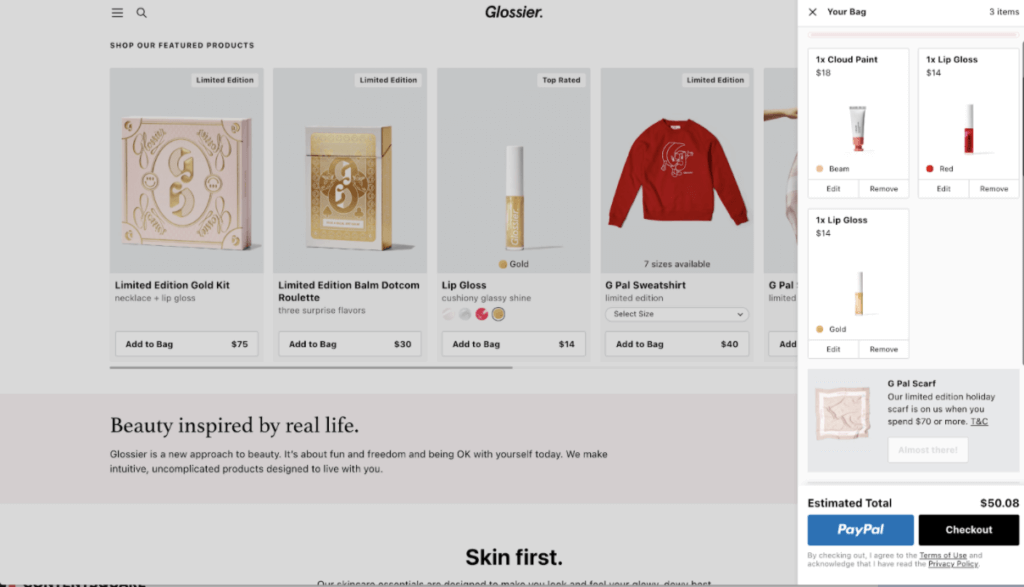A Look Back at Our Favorite 2020 eCommerce Holiday Shopping Trends & Extras

As online retailers prepped for the digital holiday season, they had to try new strategies and approaches to appeal to both existing and new customers. Brands had to make it easier for online shoppers to discover, learn about, and experience their products without the benefit of the in-store experience. And so emerged a new breed of eCommerce holiday trends.
From making the most of eye-catching homepage banners to taking a new approach to holiday gift guides, here are the top 6 eCommerce holiday trends we saw e-tailers use to improve their online experience this holiday season:
1. Navigation
To try to help customers organically find products and gifts, like they would in-store, many websites added holiday-specific navigation to their menus. To increase visibility and set it apart from other menu options, many brands made the holiday-specific navigation a different color to ensure it stood out.

Sephora added a red “Black Friday” category to its website navigation menu
For example, leading beauty retailer Sephora added a “Black Friday” category to its site navigation, as seen above on its French website. To ensure these categories caught the eye of customers, Sephora highlighted them in red and green respectively to stand out against the brand’s typical black menu text.

Bed Bath & Beyond’s holiday-specific mobile navigation bar
Home goods retailer Bed Bath & Beyond went a little further with their holiday navigation. Once clicking on “Holiday,” customers were taken to a second menu with sections for “Thanksgiving,” “Holiday Entertaining,” “Christmas,” and “Hanukkah” with specific product categories under each holiday. These detailed menu options allowed customers to quickly find what they need and reduce the number of clicks it took to find what they were looking for.
2. Promotions
With supply chain challenges and shipping delays plaguing the 2020 holiday season, it was more imperative for brands to convey urgency to their customers and encourage them to buy early. But, with brands starting holiday promotions as early as the beginning of November, many customers kept holding out for better and better deals.
One way we saw brands balance creating a sense of urgency with prioritizing transparency was with promotional countdown timers. These specified the date until which the promotion was valid, eliciting urgency with consumers while being transparent about when deals would expire.
Shopee, a leading eCommerce shopping platform in Southeast Asia and Taiwan, used countdown timers to do just that. For flash deals, they displayed the item’s original price tag with the promotion applied to it as well as how many other users had taken advantage of the deal. This gave users a clear idea of how much money they could save, how popular the item is, and when the sale price would expire.

Shopee’s promotional countdown clock and available offers on a product description page
Shopee also offered discounts based on the amount a consumer spent. To make users aware of the deals and prompt them to add more products to their cart to qualify for steeper discounts, the eCommerce platform featured the deals on the product listing page and allowed users to apply them to their carts from there.
3. Filters
Brands stepped up the specificity of their filters to help connect customers with the perfect product for the needs. Clothing company Gap created temporary filters on their gift guide page to help users narrow down results based on their gift criteria. Users could filter by price, theme, or gift recipient.

Abercrombie’s coat-specific filters allow customers to filter by coat material, color, and warmth
Another great example of innovative filtering was on clothing retailer Abercrombie & Fitch’s website. When a visitor lands on their “Coats & Jackets” category page, product-specific filters are highly visible at the top of the page. Visitors could use the interactive icons to filter products by color, material, and even degree of heat to find the perfect winter coat.
4. Out of stock
2020’s supply chain disruptions meant many retailers had inventory shortages this holiday season. That meant when things sold out, they really sold out. While some shoppers continued to hold out for better and better deals, brands had to encourage customers to shop early not only to ensure their items could be delivered in time for the holidays, but also to ensure they had the item, color, and size in stock.
Another of the eCommerce holiday trends we saw this year was the addition of an “in stock” filter. There’s nothing worse than falling in love with an item on a product listing page just to realize it’s sold out or out of your size. To avoid any unnecessary frustration with unavailable products, Bed Bath & Beyond automatically added an in-stock filter to all site searches. It also highlighted it’s free curbside pickup option at the top of the listing page, another trend that took off during the pandemic.
5. Gift Guides
This year, brands looked beyond “Men” and “Women” for their gift guide categories. Many used hyper-specific categories to segment products and help customers discover the perfect gifts for their loved ones. Categories like “Gifts for Plant Lovers,” “Gifts to Stay Warm,” “Gifts for Teen Girls,” ‘Stocking Stuffers,” etc. were a few ways brands helped customers navigate their products through their eCommerce site, as they would have done in-store.

Net-a-Porter’s product-specific holiday gift guide
Female luxury fashion brand Net-a-Porter offered an easy-to-use gift guide with clearly visible sub-categories at the top of the page, encouraging users to narrow down their search. On mobile, these subcategories are presented in the form of a slider. This helps users to narrow down list pages with an overwhelming amount of products and quickly find the types of products they need.
6. In-Cart Upsells
Every marketer loves an upsell. This holiday season, cult beauty brand Glossier offered a free gift for any customer who spent over $70. Instead of just giving customers a code to redeem at checkout and add the free item, the brand got creative. Whenever a customer added an item to their cart, a preview of their cart would appear on the right side of the page. The free gift would appear greyed out in their basket with the message, “Our limited edition holiday scarf is on us when you spend $70 or more. Almost there!” Once the customer crossed that $70 threshold, they had the option to add the limited edition gift to their cart.

Glossier’s limited-edition holiday gift with purchase automatically visible in shopper’s carts
This is a creative, highly-visible, and effective way to make your customers more aware of your promotions and encourage them to pick up a few extra items during their visit to get a special reward from your brand.
While this holiday season was unlike any other, it was a huge learning opportunity for many brands. Armed with powerful insights into new digital customer behaviors and online preferences, brands need to maintain the momentum of the holiday season and continue building innovative digital experiences their customers love. Here’s hoping these six eCommerce holiday trends inspired your own digital strategy for the rest of the year.



